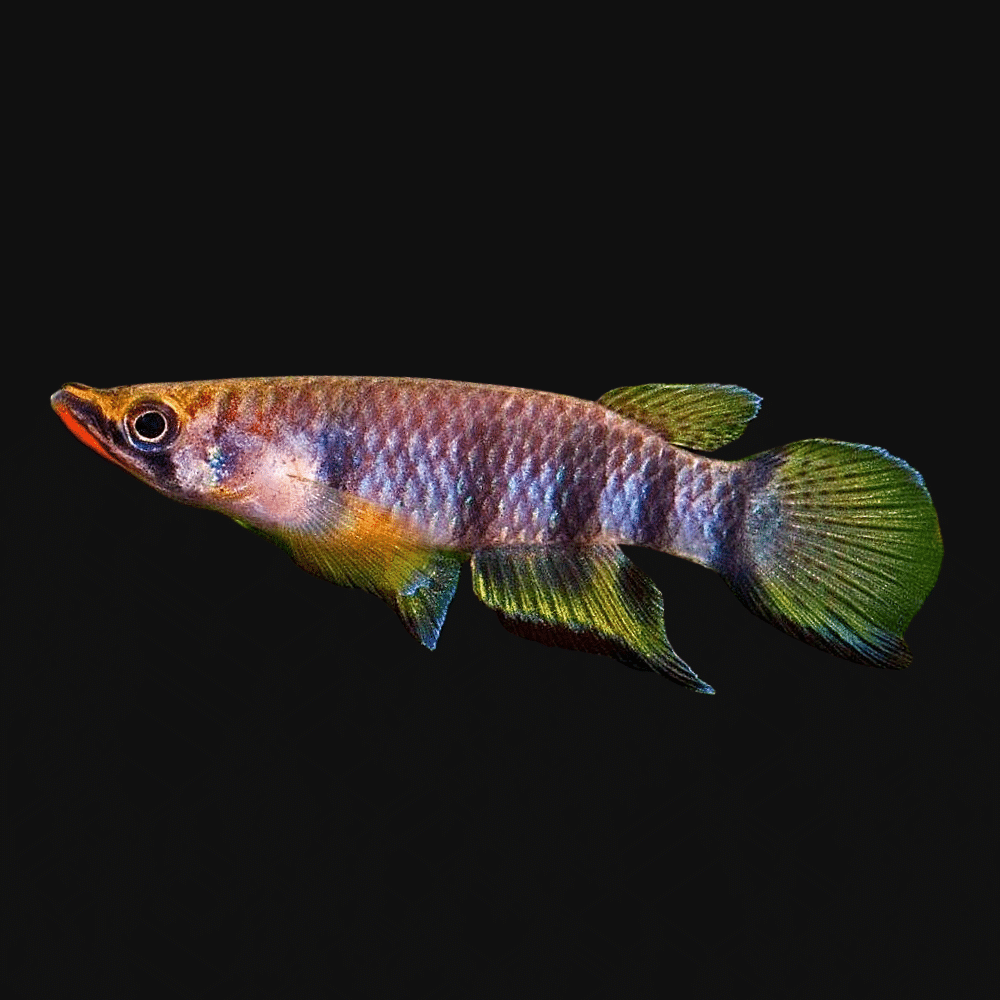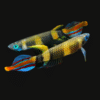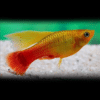Subtotal: £71.60
4 X Epiplatys Dageti Monroviae – Red-Chinned Panchax – Monrovia Killifish (4), Stunning Tropical Fish for Colorful Aquariums, Perfect Companions for Beginners and Enthusiasts Alike
£19.49 Original price was: £19.49.£16.45Current price is: £16.45.
Welcome these beautiful creatures, the 4 X Epiplatys Dageti Monroviae, known as Red-Chinned Panchax, to your aquarium. Their stunning colors and graceful movements make them perfect for community tanks. Ideal for aquarists seeking vibrant, peaceful companions among aquarium plants.
1000 in stock
Species Introduction
The Red-Chinned Panchax, scientifically known as Epiplatys dageti monroviae, is a stunning freshwater fish that belongs to the killifish family. This species is native to the rivers and streams of West Africa, particularly found in Liberia and surrounding regions. These beautiful fish thrive in well-planted environments, which mimic their natural habitat. In the wild, they inhabit shallow waters filled with dense vegetation, where they can find shelter and breeding grounds. Their vibrant colors and unique swimming patterns make them a popular choice for aquarists looking to create a lively and colorful aquarium. As peaceful community fish, they are suitable for both beginners and experienced enthusiasts alike.
Essential Care Guide for Your Red-Chinned Panchax
| Optimal Living Conditions | |
|---|---|
| Water Temperature | 24-27°C (75-81°F) |
| pH Level | 6.5-7.5 |
| Water Hardness | 4-12 dKH |
| Minimum Tank Size | 80L (20 gal) |
| Salinity | Freshwater |
| Care Level | Beginner Friendly |
The Red-Chinned Panchax is a beautiful addition to any aquarium, offering both visual appeal and a gentle disposition. They thrive in well-maintained environments and require specific care to flourish.
Natural Behavior & Temperament
The Red-Chinned Panchax is known for its peaceful demeanor and active swimming behavior. They are generally non-aggressive and can coexist harmoniously with a variety of other community fish. These fish exhibit fascinating social interactions, often seen darting around the tank and exploring their surroundings. They prefer to swim in the upper and middle levels of the aquarium, making them an engaging addition to a well-planted setup. Their natural behavior can be enhanced with the addition of floating plants and other decorations that provide hiding spots and territories. Observing their interactions and playful nature can be a delightful experience for any aquarist.
Tank Setup Guide
Creating an ideal environment for your Red-Chinned Panchax involves replicating their natural habitat as closely as possible. A minimum tank size of 20 gallons is recommended to provide ample swimming space. The substrate should be soft and sandy, mimicking the riverbeds they inhabit. Incorporate a variety of live plants, such as Java fern and Anubias, to create a lush environment. Floating plants can provide shade and cover, helping to reduce stress levels. Additionally, include driftwood and rocks to create hiding spots and territories. Ensure that the tank has gentle filtration to maintain water quality without creating strong currents, as these fish prefer calm waters.
Water Quality Management
Good Water Quality is Essential
Maintaining optimal water quality is crucial for the health of your Red-Chinned Panchax. Regular water changes of 25-30% every two weeks are recommended to keep nitrate levels low. The ideal pH level should be between 6.5 and 7.5, with temperatures ranging from 24 to 28°C (75-82°F). It is also important to monitor water hardness, keeping it between 5 and 15 dGH. Use a reliable water testing kit to regularly check these parameters and make adjustments as necessary. Additionally, ensure that the tank is equipped with a quality filtration system to maintain clear and clean water.
Feeding & Nutrition
The Red-Chinned Panchax is an omnivorous species, enjoying a varied diet that includes high-quality flake foods, frozen or live foods such as brine shrimp, daphnia, and bloodworms. A balanced diet is essential for their health and vibrant coloration. Feed them small amounts 2-3 times a day, ensuring that they consume all food within a few minutes to prevent water quality issues. It’s also beneficial to incorporate vegetable matter, such as spirulina flakes or blanched vegetables, to provide essential nutrients. Regularly varying their diet will help promote optimal health and vitality.
Compatibility Guide
Peaceful Community Fish
The Red-Chinned Panchax is known for its peaceful nature, making it an excellent choice for community tanks. They can coexist with a variety of fish species, including tetras, rasboras, and other small, non-aggressive fish. However, avoid keeping them with larger or aggressive species that may bully or eat them. It is also advisable to keep them in groups of at least six to promote social behavior and reduce stress. When selecting tank mates, consider their size and temperament to ensure a harmonious environment.
Health & Wellness
Monitoring the health of your Red-Chinned Panchax is essential for their well-being. Common issues include fin rot, ich, and other parasitic infections. Signs of illness may include lethargy, loss of appetite, or abnormal swimming behavior. To prevent health issues, maintain good water quality and provide a balanced diet. Quarantine new fish before introducing them to the main tank to prevent the spread of diseases. Regularly observe your fish for any signs of distress and consult a veterinarian specializing in aquatic animals if health concerns arise.
Breeding Information
Breeding Tips
Breeding the Red-Chinned Panchax can be a rewarding experience. To encourage spawning, provide a separate breeding tank with fine-leaved plants or spawning mops where females can lay their eggs. The ideal water temperature for breeding is around 26-28°C (78-82°F). After spawning, remove the adults to prevent them from eating the eggs. The eggs will hatch in about 10-14 days, and the fry can be fed infusoria or finely crushed flakes until they are large enough to consume regular food. Careful monitoring of the fry’s growth and health is crucial during this stage.
Acclimation Process
Introducing your Red-Chinned Panchax to their new home requires a careful acclimation process. Start by floating the sealed bag in the aquarium for about 15-20 minutes to equalize the temperature. After this, gradually add small amounts of tank water to the bag over the next hour. This step is crucial to help the fish adjust to the new water parameters. Once acclimated, gently release the fish into the tank using a net to avoid adding any transport water that may contain harmful substances. Monitor the fish closely for signs of stress or illness in the days following their introduction.
Long-term Care
The Red-Chinned Panchax has a lifespan of approximately 3-5 years when provided with proper care. Regular maintenance of water quality, a balanced diet, and a suitable environment are essential for their longevity. As they grow, ensure that the tank size is adequate to accommodate their active swimming behavior. Regularly check for any signs of illness or stress, and address any issues promptly. With proper care, these beautiful fish can thrive and bring joy to your aquarium for many years.
Natural Habitat Recreation
Biotope Setup
To create a biotope that resembles the natural habitat of the Red-Chinned Panchax, focus on replicating the water conditions and plant life found in their native streams. Use a sandy substrate and incorporate a variety of live plants, including floating and rooted varieties. The addition of driftwood and rocks can provide hiding spots and create a more natural look. Ensure that the lighting is moderate to promote plant growth while providing shaded areas for the fish to retreat. This setup not only benefits the fish but also enhances the aesthetic appeal of your aquarium.
Seasonal Care Adjustments
As temperatures fluctuate with the seasons, it is important to monitor and adjust the conditions in your aquarium accordingly. During warmer months, ensure that the water temperature remains within the optimal range of 24-28°C (75-82°F) by using fans or chillers if necessary. In colder months, consider using a heater to maintain a stable temperature. Additionally, light duration may need adjustment based on seasonal changes to ensure that plants receive adequate light while preventing algae growth. Regularly checking water parameters throughout the year will help maintain a healthy environment for your Red-Chinned Panchax.
Expert Tips
Professional Advice
To ensure the best care for your Red-Chinned Panchax, consider joining local aquarium clubs or online forums where you can share experiences and gain insights from other aquarists. Regularly participate in discussions about best practices for care and breeding. Additionally, investing in high-quality aquarium equipment, such as reliable filtration systems and water testing kits, will help you maintain optimal conditions. Lastly, always be observant of your fish’s behavior and health, as early detection of any issues can lead to successful interventions.
Troubleshooting
If you encounter issues with your Red-Chinned Panchax, such as unusual swimming patterns or loss of appetite, it is important to assess the tank conditions immediately. Check water parameters for any fluctuations, and ensure that the tank is not overcrowded. If you notice any signs of illness, such as white spots or frayed fins, consider treating the affected fish with appropriate medications while maintaining a stress-free environment. Regular maintenance and monitoring can help prevent many common issues, ensuring a healthy and thriving aquarium.
Scientific Background
Taxonomy and Conservation
The Red-Chinned Panchax belongs to the family Poeciliidae, which encompasses a variety of freshwater fish species. Their scientific classification places them within the order Cyprinodontiformes. As with many aquatic species, habitat destruction and pollution pose significant threats to their populations in the wild. By providing a home for these beautiful fish in a well-maintained aquarium, aquarists can contribute to their conservation efforts. Educating others about the importance of preserving aquatic habitats can also play a vital role in ensuring the survival of species like the Red-Chinned Panchax.
Advanced Care Techniques
For those looking to take their care of Red-Chinned Panchax to the next level, consider implementing advanced techniques such as breeding experiments or creating specialized biotope setups. Experimenting with different plant arrangements and water parameters can lead to optimal conditions for breeding and overall health. Additionally, using a variety of food sources, including live and frozen options, can enhance their coloration and vitality. Keeping detailed records of your fish’s growth and behavior can also provide valuable insights for future care and breeding endeavors.
Water Quality Parameters
Optimal Range
24-27°C
6.5-7.5
0 ppm
Caution Zone
22-24°C or 27-29°C
6.0-6.5 or 7.5-8.0
0.25-0.5 ppm
Danger Zone
<22°C or >29°C
<6.0 or >8.0
>0.5 ppm
Monitoring Tip: Test water parameters weekly and perform regular water changes to maintain optimal conditions for your aquatic friends!
Frequently Asked Questions
Q: What tank size is required for Epiplatys Dageti Monroviae?
For a school of four Epiplatys Dageti Monroviae, a tank of at least 60 litres is recommended. This size provides ample swimming space and allows for the establishment of territories, which is crucial for their well-being. The tank should be fitted with a secure lid, as these fish are known to jump. Additionally, ensure proper filtration and water circulation to maintain a healthy environment. When establishing the tank, consider including plants and decorations to create a stimulating habitat where these colourful fish can thrive.
✓ Expert Tip
Use a mixture of floating and rooted plants to provide cover and reduce stress amongst your fish friends.
Q: What water parameters do Epiplatys Dageti Monroviae require?
Epiplatys Dageti Monroviae thrive best in slightly acidic to neutral water, with a pH range of 6.5 to 7.5. The water hardness should ideally be between 5-15 dGH. Maintaining a temperature between 24-28°C is essential for their health and activity. Regular water changes of approximately 10-20% weekly will help keep the water quality high and reduce the risk of disease. It is advisable to use a water conditioner to eliminate harmful chemicals from tap water before adding it to the aquarium.
✓ Expert Tip
Consider using a reliable water testing kit to monitor pH, hardness, and ammonia levels regularly.
Q: How often should I feed Epiplatys Dageti Monroviae?
Feeding Epiplatys Dageti Monroviae should occur 2-3 times a day with small amounts of food that they can consume within a few minutes. A varied diet is essential, including high-quality flake food, frozen or live foods such as brine shrimp and daphnia. Avoid overfeeding, as this can lead to poor water quality and health issues. It is beneficial to observe your fish during feeding times to ensure they are actively eating and to adjust portions accordingly.
✓ Expert Tip
Incorporate occasional treats like freeze-dried foods to enhance their diet and promote colour vibrancy.
Q: What are the best tank mates for Epiplatys Dageti Monroviae?
Epiplatys Dageti Monroviae are generally peaceful fish and can be kept with other small, non-aggressive species. Suitable tank mates include tetras, rasboras, and other small killifish. Avoid larger or aggressive fish, as they may intimidate or harm these delicate creatures. It is also wise to ensure that all fish are of similar size to prevent bullying. Providing ample hiding spots and open swimming spaces will help reduce stress and promote a harmonious community in the aquarium.
✓ Expert Tip
Consider introducing new fish gradually to avoid overwhelming your established community.
Q: How do I properly acclimatise Epiplatys Dageti Monroviae to my aquarium?
Acclimatising your Epiplatys Dageti Monroviae is crucial to minimize stress. Begin by floating the sealed bag in the aquarium for about 15-20 minutes to equalise the temperature. Next, gradually introduce small amounts of aquarium water into the bag every 5-10 minutes for about an hour. After this period, gently transfer the fish into the tank using a net to avoid adding any transport water, which may contain harmful substances. This method helps the fish adjust to the new environment with minimal shock.
✓ Expert Tip
Always monitor your new fish for signs of stress or illness during the first few days after introduction.
Q: What are the signs of healthy Epiplatys Dageti Monroviae?
Healthy Epiplatys Dageti Monroviae exhibit vibrant colours, clear eyes, and active behaviour. They should swim freely without signs of distress or lethargy. Look for even fins and a lack of abnormalities or lesions on their bodies. Additionally, they should exhibit a healthy appetite and respond positively during feeding times. Regular observation will help aquarium keepers identify any changes in behaviour or appearance, allowing for timely intervention should any health issues arise.
✓ Expert Tip
Maintain a consistent routine in feeding and tank maintenance to support the overall health of your fish.
Q: How do I successfully breed Epiplatys Dageti Monroviae?
Breeding Epiplatys Dageti Monroviae can be a rewarding experience. To encourage breeding, provide a separate breeding tank with soft, slightly acidic water and floating plants for cover. The male will display vibrant colours to attract the female. Once spawning occurs, remove the adults after a few days to prevent them from eating the eggs. The eggs will typically hatch within a week, and the fry should be fed infusoria or finely crushed flake food until they grow larger. Maintaining optimal water conditions is key to successful breeding.
✓ Expert Tip
Ensure the breeding tank is well-planted to provide a safe environment for the fry.
Q: What temperature should I maintain for Epiplatys Dageti Monroviae?
Maintaining a temperature between 24-28°C is ideal for Epiplatys Dageti Monroviae. This range mimics their natural habitat and promotes optimal health and activity. Sudden temperature fluctuations can lead to stress and illness, so it’s important to use a reliable aquarium heater and thermometer to monitor conditions consistently. Regular checks will ensure that your aquatic companions remain comfortable and thrive in their environment.
✓ Expert Tip
Consider using a heater with an adjustable thermostat for precise temperature control.
Q: How long do Epiplatys Dageti Monroviae typically live in captivity?
In captivity, Epiplatys Dageti Monroviae can live for around 3-5 years when provided with optimal care. Factors such as water quality, diet, and tank conditions play a significant role in their lifespan. Regular maintenance of the aquarium, including water changes and monitoring of water parameters, is crucial to prevent diseases that could shorten their life. By creating a stable and healthy environment, aquarium keepers can help ensure that these beautiful fish thrive for many years.
✓ Expert Tip
Feed a balanced diet and maintain good water quality to maximise their lifespan.
Q: What type of substrate is most suitable for Epiplatys Dageti Monroviae?
For Epiplatys Dageti Monroviae, a fine substrate such as sand or small gravel is ideal. This type of substrate allows for easy digging and mimics their natural habitat. Additionally, it is essential to ensure that the substrate is free of sharp edges to prevent injury to your fish friends. A well-planted aquarium with this substrate will provide hiding spots and encourage natural behaviour, enhancing their overall well-being.
✓ Expert Tip
Consider layering your substrate with a nutritious base layer for planted tanks to promote healthy plant growth.
Q: What behavioural patterns should I expect from Epiplatys Dageti Monroviae?
Epiplatys Dageti Monroviae are typically active and social fish. They exhibit lively swimming patterns and can often be seen darting around the tank, especially during feeding times. Males are known to display vibrant colours and engage in courtship behaviours, which can be a fascinating sight for aquarium keepers. They tend to establish territories, especially during breeding, so providing ample space and hiding spots is essential to reduce aggression. Observing their interactions can be quite rewarding.
✓ Expert Tip
Create a varied environment with plants and decorations to encourage natural behaviour and reduce stress.
Q: How can I prevent common diseases in Epiplatys Dageti Monroviae?
Preventing diseases in Epiplatys Dageti Monroviae involves maintaining excellent water quality and a stress-free environment. Regular water changes and monitoring parameters such as ammonia, nitrite, and nitrate levels are vital. Quarantining new fish before introducing them to the main tank can also reduce the risk of disease transmission. Provide a balanced diet to boost their immune systems and observe them regularly for any signs of illness, such as changes in behaviour or appearance.
✓ Expert Tip
Consider adding a natural aquarium salt to the water to help prevent some common fish diseases.
Q: What lighting conditions do Epiplatys Dageti Monroviae prefer?
Epiplatys Dageti Monroviae thrive best in moderate lighting conditions. Bright lights can cause stress and make them retreat to hiding spots, while low lighting can inhibit their activity. A combination of ambient and focused lighting works well, allowing the fish to display their colours beautifully. Additionally, incorporating live plants can help diffuse the light and create a more natural environment. A light cycle of around 10-12 hours per day is recommended to simulate their natural habitat.
✓ Expert Tip
Use a timer to maintain a consistent light cycle, which can help promote healthy plant growth and fish behaviour.
Q: How do I recognise stress in Epiplatys Dageti Monroviae?
Recognising stress in Epiplatys Dageti Monroviae is crucial for their well-being. Signs of stress may include hiding more than usual, decreased activity, loss of appetite, and abnormal swimming patterns, such as darting or rubbing against objects. Changes in colour intensity can also indicate stress. It is essential to assess the water quality, tank mates, and environmental conditions if you notice these signs. Addressing the underlying cause swiftly can help restore your fish’s health and behaviour.
✓ Expert Tip
Keep a close eye on their behaviour during tank maintenance to spot any signs of stress early.
Q: What natural habitat conditions should I replicate for Epiplatys Dageti Monroviae?
To replicate the natural habitat of Epiplatys Dageti Monroviae, aim for a well-planted tank with plenty of hiding spots and open swimming areas. They are typically found in slow-moving waters with dense vegetation. Incorporating floating plants, driftwood, and rocks can create a familiar environment. Additionally, maintaining slightly acidic to neutral water conditions, with a temperature range of 24-28°C, will help mimic their natural surroundings and support their health and behaviour.
✓ Expert Tip
Consider using natural decorations to enhance the aesthetic appeal and comfort of your fish friends.















Emily Carter (verified owner) –
I recently purchased 4 Epiplatys Dageti Monroviae, and I couldn’t be happier with my decision! As an experienced hobbyist, I’ve kept various freshwater fish, but these Red-Chinned Panchax have truly captivated my heart. Their vibrant colors and playful nature add an incredible dynamic to my 20-gallon community tank.
After about two weeks of acclimatization, they’ve settled in beautifully and interact wonderfully with my other tropical fish. I’ve noticed they thrive best with a well-planted aquarium, as they love to dart in and out of hiding spots. Setting them up with some floating plants and gentle filtration has made all the difference in their comfort and happiness.
Compared to other killifish I’ve owned, these Monrovia Killifish are much more sociable and active, making them ideal for community tanks. The only minor concern is that they can be a bit shy initially, so a peaceful environment is crucial for their wellbeing. If you’re a caring fish parent looking to add some personality to your aquarium, I highly recommend these beauties. They not only look stunning but also bring so much joy! Overall, I’m thrilled with my purchase and will definitely buy again from this supplier.
Emily Carter (verified owner) –
I recently added 4 Epiplatys Dageti Monroviae to my community tank, and I couldn’t be more thrilled! These stunning tropical fish have instantly brought a burst of color and life to my aquarium. After just two weeks, they’ve settled in beautifully and are quite the little personalities! Their playful nature makes me smile every time I watch them dart around.
One thing I love about these Red-Chinned Panchax is their ability to thrive in a range of water conditions, making them perfect for both beginners and seasoned aquarists like myself. I’ve kept several types of freshwater fish, but these guys have a special charm. They’re also quite hardy, which is a big plus for anyone just starting out.
While they can be a bit shy initially, they’ve really come out of their shells and are now often seen showing off their brilliant colors. My only minor concern is that they prefer slightly calm waters, so I’ve adjusted my filter to accommodate that. Overall, I wholeheartedly recommend these beautiful killifish to anyone looking to add a splash of color to their aquarium. They’ve genuinely made my fish-keeping experience even more enjoyable!